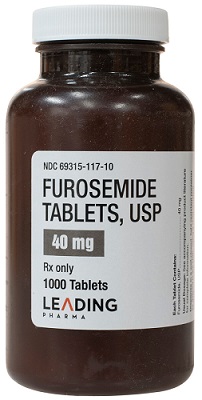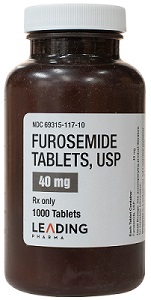Providing Quality & Trust || Clinic Website
Detailed Description
Furosemide
(fur-oh-se-mide)
- Description: Diuretic
- Other Names for this Medication: Frusemide, Lasix®, Salix®, Disal®
- Common Dosage Forms: Veterinary: 12.5 mg & 50 mg tablets; 10 mg/mL oral syrup; 50 mg/mL injectable solution.
- Human: 20 mg, 40 mg, & 80 mg tablets; 40 mg/5 mL (8 mg/mL) oral liquid; 10 mg/mL injection.
While taking this drug, your animal will urinate more often than usual. Be sure your animal always has access to fresh water. May be given with or without food.
- If your animal vomits or acts sick after receiving the drug on an empty stomach, try giving the next dose with food or a small treat. If vomiting continues, contact your veterinarian.
- Because this drug can change electrolyte (salt) levels in the blood, your veterinarian will need to monitor your animal with blood tests to make sure there are no problems related to this effect.
Contact your veterinarian immediately if weakness, collapse, head tilt, lack of urination, or a fast heartbeat is noticed.
Uses/Indications:
Furosemide is used for its diuretic activity in all species. It is used in small animals for the treatment of congestive cardiomyopathy, pulmonary edema, hypercalcemia, acute kidney injury, as adjunctive therapy in hyperkalemia, and, occasionally, as an antihypertensive agent. It can be used to decrease the incidence of sterile hemorrhagic cystitis associated with cyclophosphamide administration in dogs.
In cattle, furosemide is FDA-approved for the treatment of postparturient udder edema.
Furosemide has also been used to help prevent or reduce the severity of epistaxis (ie, exercise-induced pulmonary hemorrhage; EIPH) in racehorses. An American College of Veterinary Internal Medicine consensus statement declared that, based on the research done on EIPH in horses, there is high-quality evidence that furosemide is effective in the prophylaxis of this disease. The panel makes a weak recommendation for its use in management of racehorses with EIPH because of regulation of this issue by racing jurisdictions. The panel also found high-quality evidence that furosemide is associated with improved performance by thoroughbred and standardbred racehorses.
How is this medication useful?
Furosemide is a diuretic that works in the kidneys to remove excess water from the body in conditions associated with heartfailure, lung disease (eg, pulmonary edema), end-stage liver disease, and excessive fluid buildup in tissues.
Furosemide may also be used in racehorses that get nosebleeds when they race.
- There are furosemide products that have been approved by the FDA for use in dogs, cats, and horses.
- The FDA allows veterinarians to prescribe and use human products containing this drug in animals in certain situations.
You and your veterinarian can discuss why this drug is the most appropriate choice.
What are the side effects ofthis medication?
Common but not serious side effects include:
- Increased need to urinate. Be sure to allow your animal the chance to urinate more often, especially when starting this drug or when dosages are increased.
- Because furosemide can cause an imbalance in water and electrolytes (salts) in the body or affect kidney function, your veterinarian will likely want to do blood tests to check for these effects.
- Changes in bowel habits (diarrhea or constipation).
- You don’t have to be overly concerned if you see any of these signs unless they are severe, worsen, or continue to be a problem.
Contact your veterinarian if this happens.
Side effects that may be serious or indicate a serious problem:
- High dosages (usually given with an IV) can cause hearing or balance problems.
- If you notice that your animal seems to have lost its balance or has a slight tilt to its head.
- Weakness or collapse (passing out).
- Lack of urination.
- Rapid heartbeat.
- Very rarely, furosemide can cause anemia or other problems with blood.
If you see any of these signs, contact your veterinarian immediately.
How should this medication be given?
For this medication to work, give it exactly as your veterinarian has prescribed. It’s a good idea to always check the prescription label to be sure you are giving the drug correctly. Unless your veterinarian tells you differently, make sure that your animal has plenty of fresh, clean drinking water available while on furosemide therapy. May be given with or without food.
- If your animal vomits or acts sick after receiving the drug on an empty stomach, try giving the next dose with food or a small treat. If vomiting continues, contact your veterinarian.
- Your animal will urinate more often than normal.
If you are giving this medication more than once per day, try to avoid giving the last dose of the day within a few hours of bedtime to reduce the necessity of having to get up and let your animal out to urinate. Your veterinarian can suggest the best times to give this drug to help avoid this problem.
Do not withhold water at any time. Liquid forms of this medication must be measured carefully. Your veterinarian or pharmacist can help by providing special measuring spoons or syringes.
If you have difficulty getting your animal to take the medicine, contact your veterinarian or pharmacist for tips to help dosing and reducing the stress of medication time. This medication can be given for various lengths of time.
Be sure you understand how long your veterinarian wants you to continue giving this medication. Prescription refills may be necessary before the therapy will be complete.
Before stopping this medication, talk to your veterinarian, as there may be important reasons to continue its use.
If you have any other questions about this medication, contact your veterinarian or pharmacist.
Precautions/Warnings:
Furosemide is contraindicated in patients with anuria or hepatic coma and those that are hypersensitive to the drug. The manufacturer states that the drug should be discontinued in patients with progressive renal disease if increasing azotemia and oliguria occur during therapy.
Furosemide should be used with caution in patients with pre-existing electrolyte or water balance abnormalities, impaired hepatic function (may precipitate hepatic coma), progressive renal disease, or diabetes mellitus. Patients with conditions that may lead to electrolyte or water balance abnormalities (eg, vomiting, diarrhea) should be monitored carefully. Patients hypersensitive to sulfonamides may also be hypersensitive to furosemide (not documented in veterinary species).
Furosemide should be used cautiously with other drugs that can cause renal toxicity or ototoxicity (eg, aminoglycoside antibiotics), as furosemide may potentiate these toxic effects.
Powered by nopCommerce
This site is running in live payment mode. Real payments will be processed.

